Market
Zao Wou-Ki’s Market Is Even Hotter Than You Think. Here’s the Data to Prove It
After a record-torching year at auction in 2018, Zao Wou-Ki seems to be getting much harder to acquire—and even pricier than ever.
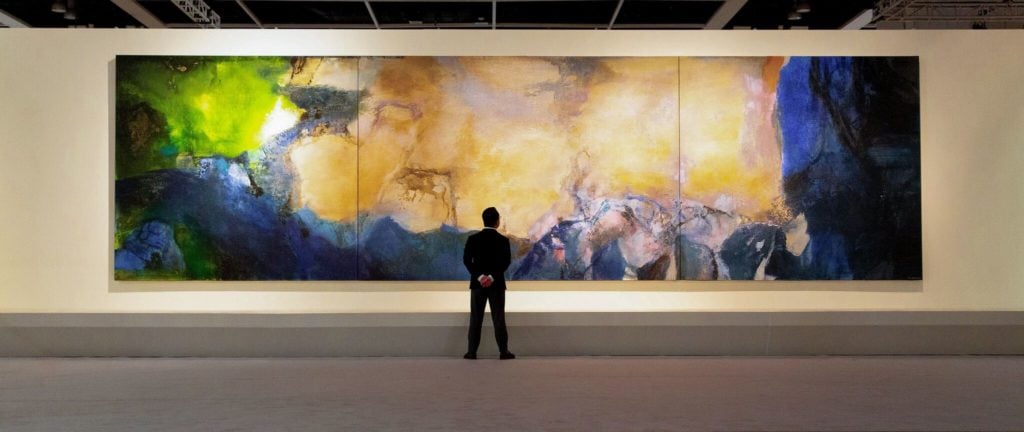
After a record-torching year at auction in 2018, Zao Wou-Ki seems to be getting much harder to acquire—and even pricier than ever.

Tim Schneider

Over the past decade, the French-Chinese painter Zao Wou-Ki has emerged as a titan in Asian art history—and a symbol of the Asian art market’s surging growth. More recently, his name has become nothing short of a global brand. According to the Spring 2019 artnet Intelligence Report, sales of Zao’s work at auction last year exceeded those of any other artist in the postwar category, including such blue-chip stalwarts as Andy Warhol, David Hockney, and Gerhard Richter.
In retrospect, it seems almost preordained that Zao should ascend in an art market increasingly looking east. Born of French and Chinese heritage in 1920 in what was then Peking, Zao spent much of his artistic career grappling with the triple influences of traditional Chinese ink painting, Parisian modernism, and American Abstract Expressionism. While his practice shifted noticeably during the several decades preceding his 2013 death, the lion’s share of his work consists of vibrant abstractions that mix these three stylistic vocabularies in varying proportions, providing a natural bridge between Chinese and western visual culture.
But while many, if not most, in the industry understand that Zao’s market has exploded in the abstract—no pun intended, despite the artist’s swirling gestural compositions—a close look at the auction data is required to appreciate just how bombastic his last several years have been.
After reviewing the numbers, here are three major takeaways from his results in the public market over the past decade, as well as a view of what lies ahead.
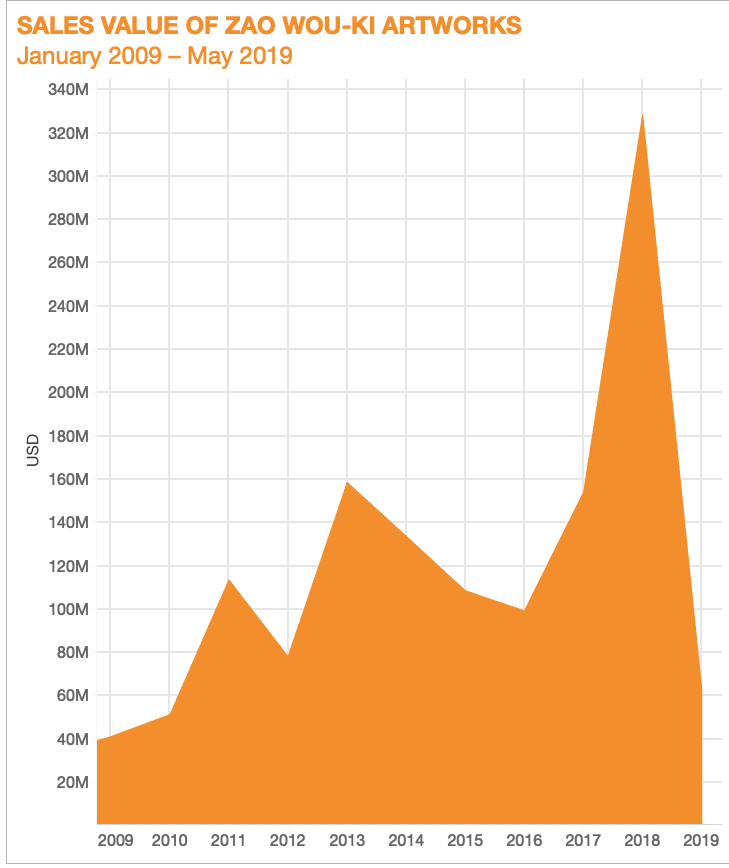
Plot of Zao Wou-Ki’s annual sales totals. © artnet Price Database 2019.
Simply noting the formidable postwar competition Zao’s sales bested doesn’t capture how berserk his market went last year. The artist’s works raked in over $328 million at auction worldwide, meaning he generated more money in annual sales than almost every other artist, alive or dead. The only artists to come out ahead of him were two all-time titans: Pablo Picasso and Claude Monet.
Granted, no small part of Zao’s astronomical total came from the sale of his monumental triptych Juin-Octobre 1985 for $65 million at Sotheby’s Hong Kong in October. But what’s remarkable is that even without that personal-best result, Zao still would have demolished his previous annual high by over $100 million—and still would have finished ahead of all artists in all categories save Picasso and Monet.
The momentum doesn’t appear to be waning, either. Through April 30 of 2019, Zao has generated a shade over $63 million in global auction sales. That four-month total already eclipses his full-year results for every calendar year from 1996 through 2011.
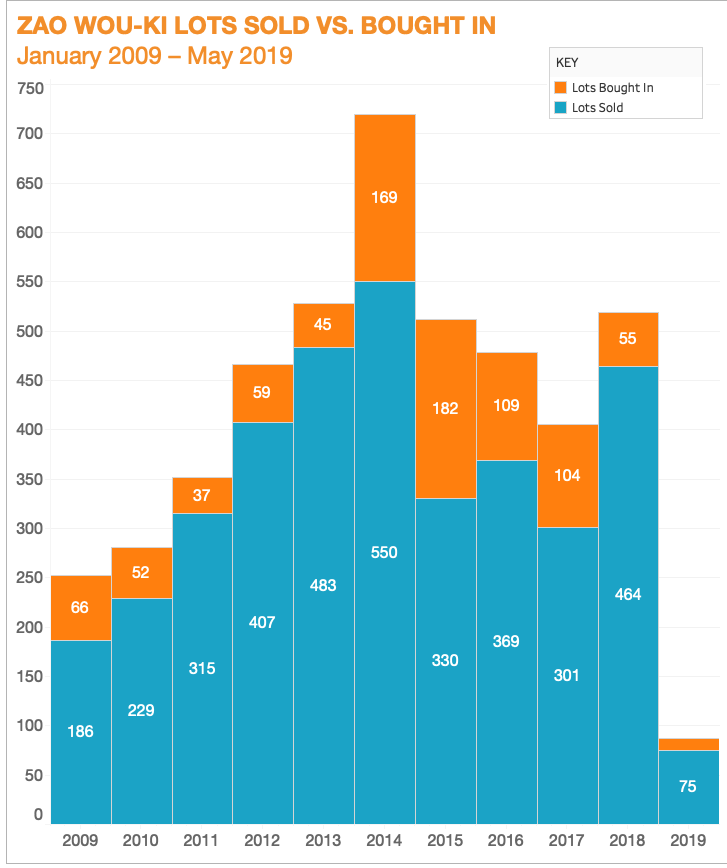
Plot of Zao Wou-Ki’s annual lots sold versus bought in. © artnet Price Database 2019.
While Zao’s $63 million in 2019 auction sales to date would not put him on pace to top his record 2018, that could be more of an indicator of supply than demand.
So far, only 87 Zao works have been offered this year, with 75 of them finding buyers. If the same rate of consignment were to hold for the remaining eight months of 2019, it would mean that only 261 lots would come to the public market by year’s end.
That would be the lowest annual total since 2009, when 252 of his works went under the hammer (and about a quarter of those were bought in). No wonder, then, that the data also says buyers will be ravenous for however many—or few—opportunities present themselves at auction.
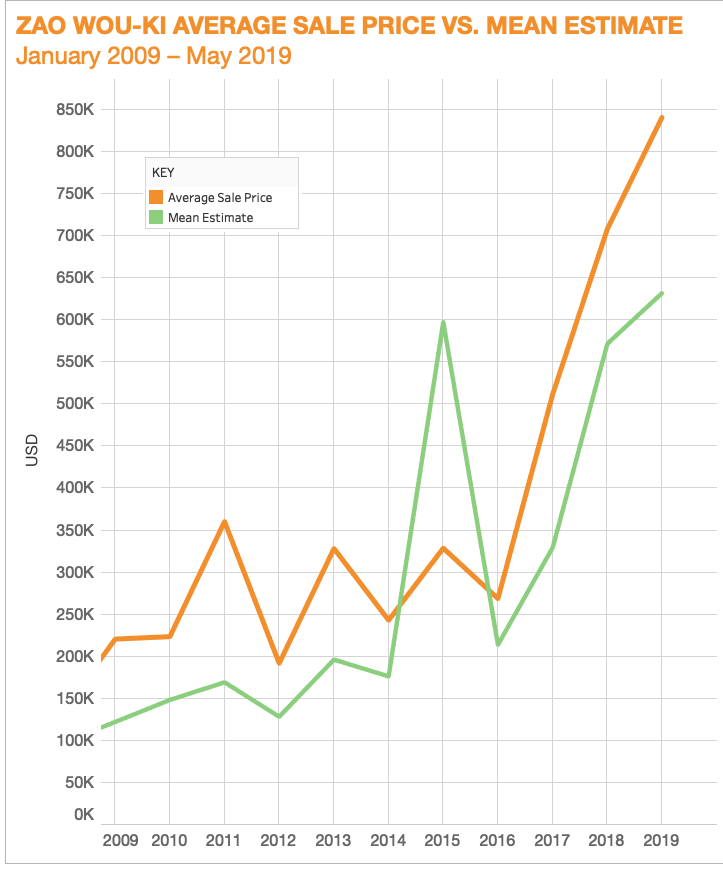
Plot of Zao Wou-Ki’s average sale price per work versus mean estimate per work. © artnet Price Database 2019.
There might be fewer works by the artist coming up at auction, but those that do make it to the block are becoming more expensive. The mean estimate for a Zao work at auction in 2019 currently stands at around $631,500, a significant leap over the equivalent figure—$571,000—in his record-setting 2018.
Zao’s average sales price at auction has also taken a jump this year, to around $840,000 to date. That places it well above the roughly $708,000 average sales price achieved in 2018. Note that this year’s figure has risen despite the fact that it does not reflect a monstrous sale like last year’s $65 million Juin-Octobre 1985—suggesting that 2018 may be less of an anomaly than its one outsize result might lead us to believe in isolation.
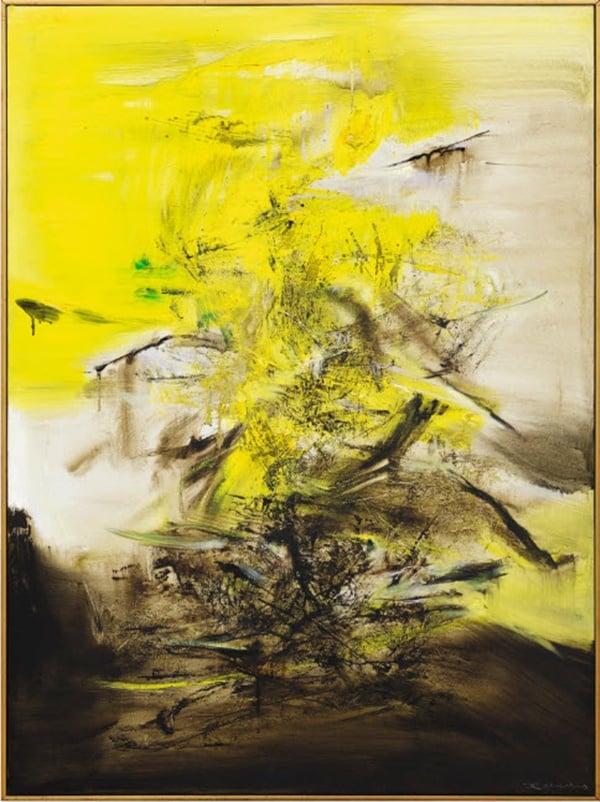
Zao Wou-ki, 17.07.67,1967. Courtesy Sotheby’s.
Of course, between today and December 31, Zao’s auction market could diverge dramatically from the trail it’s blazed so far this year. However, there is qualitative evidence that his work will indeed become a scarcer commodity in the public market going forward.
Although the Zao-Wou Ki Foundation has been consistently active since its establishment in Switzerland in 2012, the nonprofit entity has never controlled or sold any of the artist’s work. Its mandate has been strictly limited to scholarship, publication, and promotion of Zao’s legacy, most notably by organizing exhibitions with museums and galleries including powerhouse commercial spaces Lévy Gorvy in 2017 and Kamel Mennour this spring.
In contrast, Zao’s estate has only recently been liberated from litigation-induced traction. For roughly four years after the artist’s 2013 death, control of the estate was tied up in lawsuits between Zao’s third wife, Françoise Marquet, and Jia-Ling Zhao, his son from his first marriage. The dispute left in limbo a cache of artworks valued at up to €500 million in 2013, according to the Financial Times, forcing would-be collectors to prowl the resale market to satisfy their cravings.
However, the courts definitively ruled in favor of Marquet in September 2017, theoretically freeing her to exhibit or sell works from the estate if and when she sees fit going forward. (According to a spokesperson from the Zao Wou-Ki Foundation, the works in this year’s Kamel Mennour show were still sourced entirely from private collections.) Securing high-level gallery representation seems like an inevitable move for the estate, particularly since one can only guess how high the aforementioned €500 million valuation has climbed in the past six years based on the data above.
If and when that move is made, a significant portion of the Zao trade will begin shifting to the private market. This doesn’t mean that his auction market will completely dry up, of course. But some collectors will undoubtedly be able to acquire Zao’s work through the gallery system at that point, which likely means fewer pieces being offered publicly.
At the same time, with Zao now blazing bright in the global art market, buyers unable to acquire privately are likely to battle it out even harder for the works consigned to the auction houses. And that could mean that, as the old cliché goes, his latest auction records were made to be broken—and perhaps sooner than you might think.
Methodology: This article examines all fine-art auction results for Zao Wou-Ki across all media in sales held from January 1, 1996 through April 30, 2019 at more than 1,800 auction houses worldwide. All sales values are denominated in US dollars and include buyer’s premiums. All data comes courtesy of the artnet Price Database and artnet Analytics Reports.